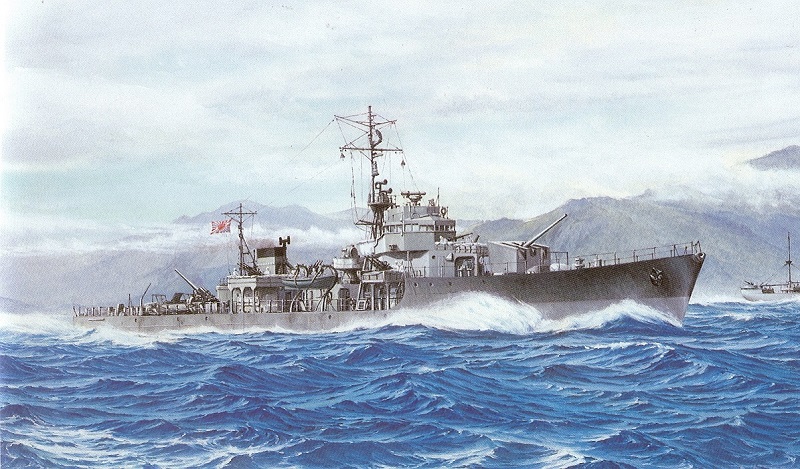© 2009-2014 Bob Hackett and Peter Cundall
Revision 1
1944:
Tokyo. Laid down at the Uraga Dockyard.
11 March 1945:
Launched and named IKINO. LtCdr (Reserve) Nihei Kou (former CO of KUME) is appointed CO.
17 July 1945:
Completed. Assigned to the Kure Guard Unit.
August 1945:
Reassigned to the Maizuru Naval District in the 51st Division.
15 August 1945:
Tokyo. Japan accepts the Allies “Potsdam Declaration” (of unconditional surrender) and hostilities cease.
15 September 1945:
Removed from the Navy List.
21 October 1945:
Departs Uraga.
25 October 1945:
Arrives at Ogasawara Gunto (Bonin Islands). Embarks troops and passengers to be repatriated and departs later that day.
28 October 1945:
Arrives at Uraga. Disembarks troops and passengers.
29 October 1945:
Enters dockyard at Yokohama for repairs.
1 December 1945:
Assigned to the Allied Repatriation Service as a special cargo ship. [1]
5 December 1945:
Repairs completed and departs Yokohama the same day.
9 December 1945:
Arrives at Chichi-jima. Embarks troops and passengers to be repatriated and departs later that same day.
11 December 1945:
Arrives at Uraga. Disembarks troops and passengers.
13 December 1945:
Departs Uraga.
15 December 1945:
Arrives at Chichi-jima. Embarks troops and passengers to be repatriated.
18 December 1945:
Departs Chichi-jima.
20 December 1945:
Arrives at Uraga. Disembarks troops and passengers.
5 January 1946:
Departs Uraga.
8 January 1946:
Arrives at Guam. Embarks troops and passengers to be repatriated.
9 January 1946:
Departs Guam.
11 January 1946:
Arrives at Truk. Embarks troops and passengers to be repatriated.
17 January 1946:
Departs Truk.
23 January 1946:
Arrives at Pusan. Embarks troops and passengers to be repatriated and departs later the same day.
24 January 1946:
Arrives at Hakata. Disembarks troops and passengers.
29 January 1946:
Enters dockyard at Uraga for repairs.
10 March 1946:
Repairs are completed.
11 March 1946:
Departs Uraga.
14 March 1946:
Arrives at Sasebo.
17 March 1946:
Departs Sasebo.
20 March 1946:
Arrives at Shanghai. Embarks troops and passengers to be repatriated and departs later the same day.
22 March 1946 :
Arrives at Sasebo. Disembarks troops and passengers.
26 March 1946:
Departs Sasebo.
27 March 1946:
Arrives at Shanghai and departs later that day.
29 March 1946:
Arrives at Sasebo. Disembarks troops and passengers.
4 April 1946:
Departs Sasebo.
6 April 1946:
Arrives at Shanghai. Embarks troops and passengers to be repatriated.
9 April 1946:
Departs Shanghai.
11 April 1946:
Arrives at Sasebo. Disembarks troops and passengers.
3 May 1946:
Departs Sasebo.
5 May 1946:
Arrives at Shanghai. Embarks troops and passengers to be repatriated.
8 May 1946:
Departs Shanghai.
12 May 1946:
Arrives at Sasebo. Disembarks troops and passengers.
17 May 1946:
Departs Sasebo.
21 May 1946:
Arrives at Shanghai. Embarks troops and passengers to be repatriated and departs later that day.
24 May 1946:
Arrives at Sasebo. Disembarks troops and passengers.
30 May 1946:
Departs Sasebo.
1 June 1946:
Arrives at Shanghai. Embarks troops and passengers to be repatriated and departs later that day.
2 June 1946:
Arrives at Sasebo. Disembarks troops and passengers.
3 June 1946:
Enters dockyard at Tamano for repairs.
20 July 1946:
Repairs are completed.
29 July1947:
Nakhodka, Siberia. Ceded to the Soviet Union as a war
reparation.
Authors' Note:
[1] Allied occupation forces were responsible for the return of six million Japanese military personnel and civilians from Japan's defunct far-flung Empire. In addition, there were over a million Korean and about 40,000 Chinese prisoners and conscript laborers and approximately 7,000 Formosans and 15,000 Ryukyu Islanders to be repatriated.
Some Allied and many former IJN warships, from aircraft carriers to kaibokan, were used to facilitate the enormous repatriation effort. Japanese vessels and crews were used to the fullest extent possible to conserve Allied manpower and accelerate demobilization. Each ex-IJN ship first had to be demilitarized; guns removed or, in the case of large warships, barrels severed, ammunition landed, and radar and catapults removed, if fitted. Repatriation of the Chinese on Japanese ships began early in October from Hakata, but U.S. guard detachments had to be placed on many ships to prevent disorder because the Japanese crews could not control the returnees.
Japanese-run repatriation centers were established at Kagoshima, Hario near Sasebo, and Hakata near Fukuoka. Other reception centers were established and operated at Maizuru, Shimonoseki, Sasebo, Senzaki, Kure, Uraga, Yokohama, Moji and Hakodate. Allied line and medical personnel supervised the centers. Incoming Japanese were sprayed with DDT, examined and inoculated for typhus and smallpox, provided with food, and transported to his final destination in Japan.
Thanks to Jeff Donahoo of Iowa, USA and Gilbert Casse of France.
-Bob Hackett and Peter Cundall
Back to
Escort Page



